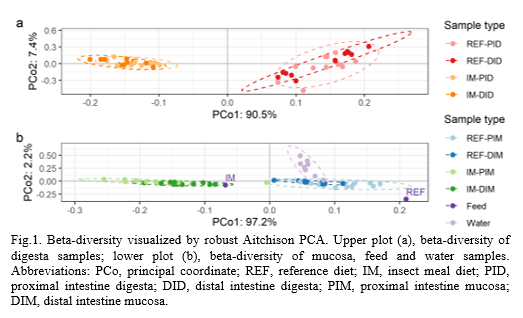REPRODUCIBLE CHANGES IN THE INTESTINAL MICROBIOTA OF ATLANTIC SALMON FED DIETS CONTAINING BLACK SOLDIER FLY LARVAE MEAL
Introduction
Limited availability of sustainable feed ingredients is a major obstacle in the continuous growth of salmon aquaculture. Being part of the natural diet of salmonids, insects are a good source of nutrients for salmon. Insects possess an outstanding capacity to upgrade low-quality organic materials, require minimal water and cultivable land, and emit little greenhouse gases (Van Huis, 2013). Among the insect species suitable as feed ingredients, black soldier fly (Hermetia illucens) has been produced at an industrial scale for its good nutritional value (Barroso et al., 2014). In recent years, extensive research efforts have been directed to investigate its potential as a sustainable feed ingredient for various fish species including Atlantic salmon (Salmo salar). However, less is known regarding its influence on the intestinal microbiota. Herein, we report the response of intestinal microbiota in pre-smolt Atlantic salmon fed an insect meal diet containing 60% black soldier fly larvae meal for 8 weeks.
Materials and methods
Atlantic salmon with a mean initial body weight of 49 g (1.5 g SEM) were randomly assigned into 8 fiberglass tanks (450 L, 100 fish per tank). Quadruplicate tanks of fish were fed either a commercially relevant reference diet (REF), or an insect meal diet (IM) wherein black soldier fly larvae meal accounted for 60% of total ingredients. At the end of the feeding trial, digesta and mucosa samples from different intestinal compartments (proximal and distal) were collected in addition to feed and water samples from both dietary groups. Samples were processed along with positive and negative controls. Microbial communities were profiled by sequencing V1-2 regions of the 16S rRNA gene.
Results
Overall, the microbial diversity was lower in the digesta of fish fed the insect meal diet but higher in the mucosa. Regardless of the intestinal compartment, the insect meal diet markedly modulated the intestinal microbiota composition in both digesta and mucosa (Fig.1). The diet effect on the mucosa microbiota, however, was stronger in the proximal intestine than the distal intestine. We also found that the feed-borne microbiota showed close resemblance to those observed in the intestine, whereas the water microbiota was distinct from the others. Irrespective of the intestinal compartment, bacterial taxa classified as Actinomyces, Bacillaceae, Bacillus, Beutenbergiaceae, Brevibacterium, Corynebacterium 1, Enterococcus, Lactobacillales, Microbacterium, Oceanobacillus, and RsaHF231 were enriched in both intestinal digesta and mucosa of salmon fed the insect meal diet.
Discussion and conclusion
Our current study largely reproduced what we found in a previous experiment wherein post-smolt Atlantic salmon were fed an insect meal diet containing 15% black soldier fly larvae meal for 16 weeks (Li et al., 2021). Despite the huge difference in the inclusion level of black soldier fly larvae meal, marked changes in the digesta- and mucosa-associated intestinal microbiota were observed in both studies. In particular, insect meal diets seem to enrich specific microbial clades in the salmon intestine as outlined in the Results section. Notably, most of these taxa were also found in the feed pellets. As sequencing-based methods do not differentiate between living and dead cells, the viability of these bacterial taxa in the salmon intestine warrants further investigations. Potential implications of the changes in the intestinal microbiota for salmon physiology and health are being analyzed and will be discussed in the context of their associations with host response data that we reported elsewhere (Li et al., 2020).
Reference
Barroso, F. G., de Haro, C., Sánchez-Muros, M.-J., Venegas, E., Martínez-Sánchez, A., & Pérez-Bañón, C. (2014). The potential of various insect species for use as food for fish. Aquaculture, 422-423, 193-201. doi:10.1016/j.aquaculture.2013.12.024
Li, Y., Bruni, L., Jaramillo-Torres, A., Gajardo, K., Kortner, T. M., & Krogdahl, Å. (2021). Differential response of digesta- and mucosa-associated intestinal microbiota to dietary insect meal during the seawater phase of Atlantic salmon. Animal Microbiome, 3(1), 8. doi:10.1186/s42523-020-00071-3
Li, Y., Kortner, T. M., Chikwati, E. M., Belghit, I., Lock, E.-J., & Krogdahl, Å. (2020). Total replacement of fish meal with black soldier fly (Hermetia illucens) larvae meal does not compromise the gut health of Atlantic salmon (Salmo salar). Aquaculture, 520, 734967.
Van Huis, A. (2013). Potential of insects as food and feed in assuring food security. Annu Rev Entomol, 58, 563-583. doi:10.1146/annurev-ento-120811-153704
